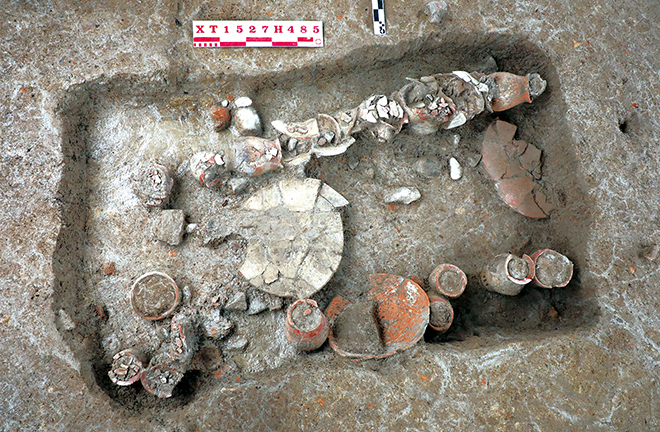Xiatang site: A fresh window into early rice cultivation

FILE PHOTO: A burial site discovered at Xiatang site
The Xiatang Neolithic site in Xianju County, Zhejiang Province, is situated in a mountainous basin and covers an area of approximately 30,000 square meters. Dating back to around 9,300 to 8,400 years ago, it belongs to the middle and late phases of the Shangshan culture [an important Neolithic culture in the lower Yangtze River region] in the early Neolithic period. Archaeological evidence indicates the early Shangshan culture emerged in this region roughly 10,000 years ago. Excavated animal and plant remains suggesting that fishing, hunting, and gathering remained dominant subsistence strategies, while early settled villages displayed relatively simple forms. In contrast, settlements from the middle and late Shangshan culture, exemplified by the Xiatang site, exhibit more mature characteristics of early rice-based agricultural societies, with abundant remains and artifacts.
The Xiatang site is positioned on a slightly elevated hill surrounded by ditches, making it one of the earliest known moat-enclosed settlements in China. A large natural terrace extends across the central and southwestern sections of the moat, where dense clusters of postholes have been uncovered. Some postholes outline circular house sites with grooves, while others, more dispersed, suggest stilted structures. Additionally, rectangular house sites with base pits but no postholes were identified, some featuring partitions—an indication of relatively advanced architectural forms.
North of the residential area lies a small “plaza” paved with red-burnt soil, where numerous “artifact pits” are scattered. These pits primarily revealed pottery groupings, with some pits also containing stone tools such as grindstones. Further discoveries in the eastern and northern sections of the moat include over a dozen artificial earthen platforms, many containing similar “artifact pits,” likely used for food storage and processing. On the eastern platforms, several potential burial sites were unearthed, with many pottery items placed inside.
The Xiatang site also yielded a significant number of animal and plant remains, including numerous rice-related specimens among the carbonized plants. Preliminary research indicates that cultivated rice with domesticated traits constitute a substantial portion of the findings. The widespread distribution of residential sites, specialized storage and processing facilities, and abundant rice remains suggest that, the Xiatang site, dating back to around 9,000 years ago, represented a relatively mature early rice-based agricultural society.
Traditionally, the world’s earliest form of agriculture was believed to have emerged around 10,000 years ago in the Fertile Crescent of West Asia, where wheat cultivation led to the rise of a fully developed agricultural society around 9,000 years ago. However, recent archaeological discoveries suggest that rice cultivation and the formation of early agricultural societies in China may have occurred contemporaneously, reshaping our understanding of early agricultural development.
Dai Xiangming is a professor from the School of History at Capital Normal University.
Edited by REN GUANHONG
